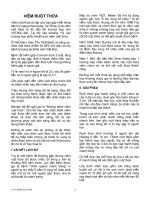VIÊM RUỘT THỪA doc
Bạn đang xem bản rút gọn của tài liệu. Xem và tải ngay bản đầy đủ của tài liệu tại đây (43.68 KB, 4 trang )
VIÊM RUỘT THỪA
Anatomy and embryology
Embryologically, the appendix and cecum develop as outpouchings of the caudal
limb of the midgut loop in the sixth week of human development. By the fifth
month, the appendix elongates into its vermiform shape. At birth, the appendix is
located at the tip of the cecum, but due to unequal elongation of the lateral wall of
the cecum, the adult appendix typically originates from the posteromedial wall of
the cecum, caudal to the ileocecal valve. The appendix averages 9 cm in length,3
with its outside diameter ranging from 3–8 mm and its lumen ranging from 1–3
mm. The base of the appendix is consistently found by following the teniae coli of
the colon to their confluence at the base of the cecum. The appendiceal tip,
however, can vary significantly in location. Although usually located in the right
lower quadrant or pelvis, the tip can occasionally reside in the left lower or right
upper quadrants. The arterial supply of the appendix comes from the appendicular
branch of the ileocolic artery, which originates posterior to the terminal ileum and
enters the mesoappendix near the base of the appendix. Lymphatic drainage flows
to lymph nodes along the ileocolic artery.
Signs & symptoms
The classic presentation of acute appendicitis begins with crampy, intermittent
abdominal pain, thought to be due to obstruction of the appendiceal lumen. The
pain may be either periumbilical or diffuse and difficult to localize. This is
typically followed shortly thereafter with nausea; vomiting may or may not be
present. If nausea and vomiting precede the pain, patients are likely to have
another cause for their abdominal pain, such as gastroenteritis. Classically, the
pain migrates to the right lower quadrant as transmural inflammation of the
appendix leads to inflammation of the peritoneal lining of the right lower
abdomen. This usually occurs within 12–24 hours of the onset of symptoms. The
character of the pain also changes from dull and colicky to sharp and constant.
Movement or Valsalva maneuver often worsens this pain, so that the patient
typically desires to lie still; some patients describe pain with every bump in the car
or ambulance ride to the hospital. Patients may report low-grade fever up to 101°F
(38.3°C). Higher temperatures and shaking chills should again alert the surgeon to
other diagnoses, including appendiceal perforation or nonappendiceal sources.
When questioned, patients who have appendicitis commonly report anorexia;
appendicitis is unlikely in those with a normal appetite. A hungry patient does not
have acute appendicitis.
Complications
The most frequent complication of appendicitis is perforation. Perforation of the
appendix can lead to a periappendiceal abscess (a collection of infected pus) or
diffuse peritonitis (infection of the entire lining of the abdomen and the pelvis).
The major reason for appendiceal perforation is delay in diagnosis and treatment.
In general, the longer the delay between diagnosis and surgery, the more likely is
perforation. The risk of perforation 36 hours after the onset of symptoms is at least
15%. Therefore, once appendicitis is diagnosed, surgery should be done without
unnecessary delay.
A less common complication of appendicitis is blockage of the intestine.
Blockage occurs when the inflammation surrounding the appendix causes the
intestinal muscle to stop working, and this prevents the intestinal contents from
passing. If the intestine above the blockage begins to fill with liquid and gas, the
abdomen distends and nausea and vomiting may occur. It then may be necessary
to drain the contents of the intestine through a tube passed through the nose and
esophagus and into the stomach and intestine.
A feared complication of appendicitis is sepsis, a condition in which infecting
bacteria enter the blood and travel to other parts of the body. This is a very serious,
even life-threatening complication. Fortunately, it occurs infrequently.
Manage
Most patients with acute appendicitis are managed by prompt surgical removal of
the appendix.
Open versus Laparoscopic Appendectomy:









